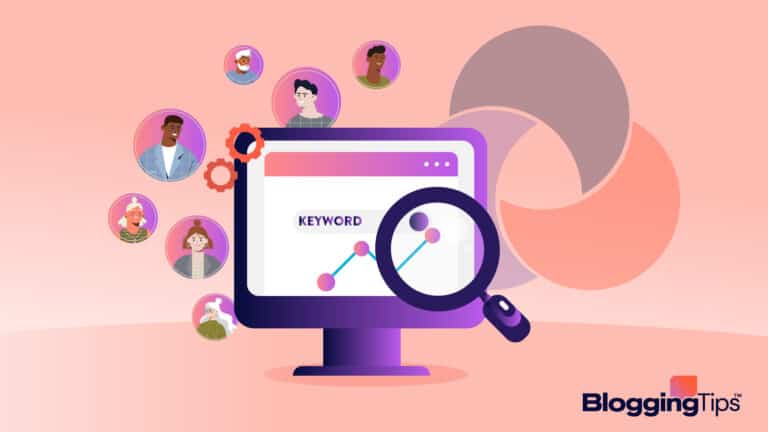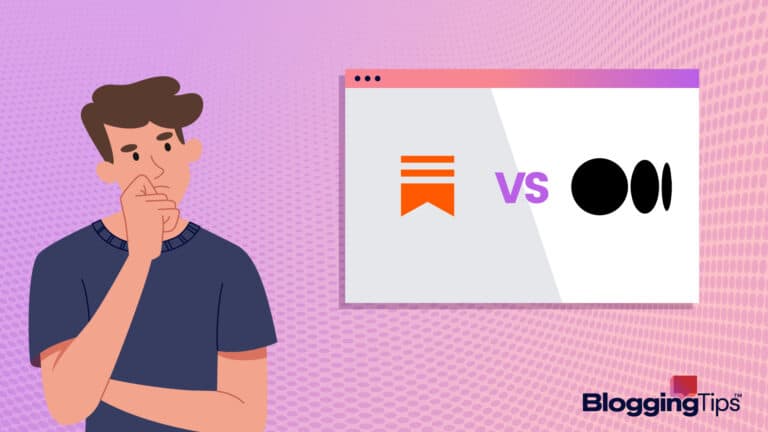The right design software can help you take ideas from your head and turn them into reality.
Whether you’re a seasoned professional considering new software or you’re a beginner looking for easy-to-use software to get started with, there are dozens of options on the market.
Of course, with so many options to choose from, selecting the perfect design software for you can be a challenge.
Today, we’ll take a closer look at the best design software on the market and share some helpful tips to ensure you choose the best software for your needs.
- The Best Design Software (Overview)
- An Overview of Design Software
- Features To Look For in Design Software
- Best Design Software: Our Top 3 Options [Ranked & Reviewed]
- Canva: Budget Pick
- The Best Free Design Software Options
- Setka Editor
- Notable Mentions: Notable Mentions: Other Design Software To Check Out
- Even More Options To Check Out
- Other Products Relevant to Design Software
- Frequently Asked Questions
- Wrapping Up
The Best Design Software (Overview)
We’ve included an overview of our top picks below.
For detailed information on each pick, scroll down.
Our Top Picks
- Adobe Illustrator: Our Pick
- Adobe InDesign: Runner-Up
- Canva: Budget Pick
Best Free Options
Additional Options
An Overview of Design Software
Having a better understanding of design software can help you choose the best one for your needs.
Here are some of the things worth knowing about these important graphics tools and how you can use them to achieve your business goals.
What Is Design Software?
Design software is a computer program that allows you to manipulate 2-dimensional and 3-dimensional images and graphics.
This software can edit photographs and images, create the front-end design of websites, or create artwork.
Design software can also create 3D renderings for printing or sculpture.
Graphic design software is critical for getting your message to your audience, and providing them with engaging content.
Why Is Design Software Important?
Design software is a critical tool across virtually every industry.
It enables artists and designers to create within a digital landscape that’s native to the way other departments do business.
Its uses include print advertising, website design, 3D object printing, and editing photos.
Do I Need a Design Software?
Your need for design software will largely depend on three factors.
The type of business you’re in, how much design work your business requires, and your capacity to do the work.
If you only need to occasionally create graphics or don’t think you can learn to use design software, you may be better off working with a freelance designer for your graphic needs.
Whether you design your own graphics or work with a contractor, it’s crucial that each design is professional and polished and speaks to the intent of your business, products, or services.
The Best Design Software at a Glance
Curious about which design software is best? We’ll give you the bottom line up front.
Here are the two best options on the market today for both paid and free options.
What Is the Best Design Software?
The best design software available today is Adobe Illustrator.
This software provides the broadest range of tools, and it’s the industry-leading software regardless of the type of work you’re creating.
Illustrator offers the most tools.
It also provides a working environment that isn’t restrictive and allows the designer to fully exercise their creativity.
What Is the Best Free Design Software?
For businesses and individuals looking for the best free design software, DesignWizard is our top choice.
DesignWizard’s free plan gives users access to an extensive range of tools, templates, and design resources.
It’s the ideal tool for anyone with occasional graphic design needs.
Features To Look For in Design Software
Whether seasoned or a rookie, there are a few things that any designer should keep in mind when evaluating different design software.
Here’s what to look for.
Accessibility
In recent years, many of the most popular design tools have moved to a cloud-based model where all tools are hosted online.
This arrangement has made design tools more affordable and accessible than ever.
That is until you’re working on a project somewhere without internet access.
More and more tools are moving to a cloud-based model that requires internet access.
But, some software still includes a desktop client that allows you to work regardless of whether you have internet access.
Collaboration Tools
If you’re working with many people on your team, you must be able to easily share your work with your peers.
The best design tools have baked-in collaboration features that make it easier for your team to work together.
Some programs even allow for real time collaboration where you can see what other team members are doing in the program as you work.
Tool Selection
In the past, each design application performed a more distinct function.
Photoshop was the industry standard for photo and image editing.
Meanwhile, graphic designers preferred InDesign.
Today, the lines between each application are blurrier.
Most design software provide capable tools that allow you to handle all your design needs with a single program.
If you’re looking for one-stop-shop design software, ensure that it provides all the tools you’ll need to tackle the kinds of graphics you need to create.
Customizable User Interface
Depending on your needs, you may need vastly different things from someone who uses the same software.
So choose an option that allows you to build a customized environment that makes sense for your work and the tools you need most.
Product Support
Whether you’re a novice or a veteran, you’ll never stop learning new tips and tricks about the design software you choose.
Many products, such as those in the Adobe Creative Suite and CorelDRAW, have an engaged community of users.
These users regularly share tips, ideas, and guides to help you make the most of the software.
Best Design Software: Our Top 3 Options [Ranked & Reviewed]
Now that you’re armed with some basic knowledge of design software take a closer look at our top three options.
Adobe Illustrator: Our Pick
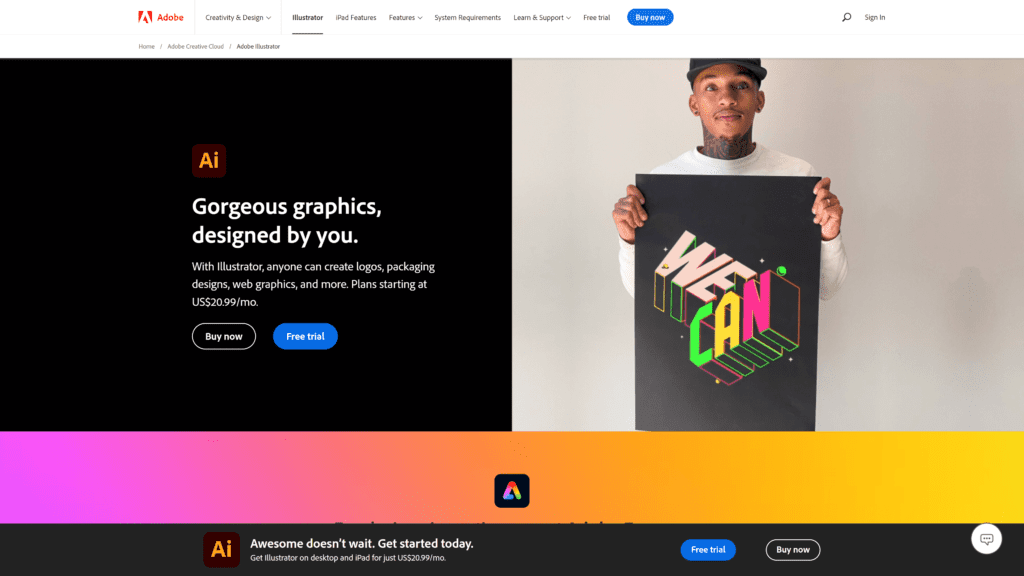
Adobe Illustrator has been the undisputed champion of vector graphics editors for over thirty years and is still the industry leader today.
Illustrator has maintained its grip on the industry by constantly iterating the software and incorporating new features that designers love.
Key Features of Adobe Illustrator
- Discovery Panel: Native help that offers tutorials, tips, and user guides to help new users navigate the program. It also shows design mistakes to avoid.
- New share functions: Collaboration has never been easier thanks to the integrated share button. It allows you to show your work to other stakeholders and receive feedback.
- Customizable workspace: Easily customize tool selection and program custom commands. You can also generally tailor the look and feel of the workspace to best fit your needs.
- Automation: Powerful automation tools allow you to apply effects and styles to a layer with one click.
- Creative Cloud: Syncs asset libraries across desktop and mobile applications. That way you can work seamlessly across different devices and platforms.
Why is Adobe Illustrator a Great Solution?
Adobe Illustrator is a great solution for designers because of its industry-leading range of features.
It also has a track record for excellence.
Illustrator has been on the market since 1987 and is still the industry leader.
Illustrator’s longevity speaks to how well-designed and intuitive the software is.
Moreover, it doesn’t appear that any of Adobe’s competition will take a shot at the throne soon.
Pros of Adobe Illustrator
- Unrivaled vector design tools
- Constant improvements to existing features
- Discover panel makes it easy to learn new features and tools
Despite its three-decade reign atop the design software industry, Illustrator remains committed to constantly updating its tools and ensuring they’re the best the industry offers.
It’s also easier than ever to discover new features and learn the program, thanks to the Discover panel.
Cons of Adobe Illustrator
- No longer offers a perpetual license
- Keyboard shortcuts don’t match other Adobe programs
- Has a steep learning curve
Unfortunately, Illustrator is now only available on a subscription basis, and there’s no way to purchase the software and own it for life.
Keyboard shortcuts for Illustrator are also different than those in other Adobe programs, such as Photoshop or InDesign.
Furthermore, since Illustrator’s tools are so high-level, there is a bit of a learning curve associated with the program.
Adobe Illustrator vs. Other Top Recommendations: How They Compare
Several other programs offer a similar suite of features and tools as Illustrator, including CorelDRAW and Canva.
These applications can mimic some of Illustrator’s core functionality.
But they fall short of what Illustrator offers.
Adobe Illustrator Pricing
- Individual License: $31.49 per month ($239.88 per year)
- Business License: $35.99 per month ($431.88 per year)
Can You Try Adobe Illustrator for Free?
New users are able to try Illustrator for free for seven days.
You’ll have access to the full program during the trial period.
And you’ll only be charged for the service if you don’t cancel it within the seven-day trial period.
Conclusion: Should You Choose Adobe Illustrator?
If you’re serious about graphic design, there’s no better software suite to help bring your ideas to life than Adobe Illustrator.
For occasional design tasks, Illustrator may be more powerful and full-featured than you need.
Adobe InDesign: Runner-Up
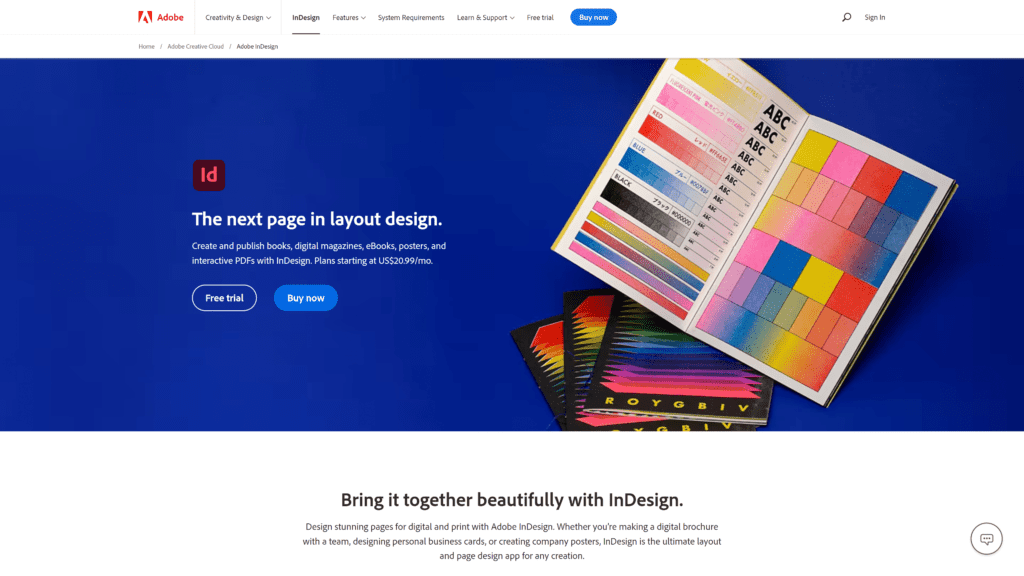
Another indispensable tool in Adobe’s selection of applications is InDesign.
This powerful design software is a go-to option for developing graphics that include vector and raster-based images and text.
For brochures, flyers, or the design of a blog or website, InDesign is a proven solution.
Key Features of Adobe InDesign
- Liquid Layout: For designing content for the web, InDesign provides multiple layout environments within a single document. This allows you to adapt to different displays.
- Content Conveyor: A unique timeline-based toolbar of commonly used assets and styles that can save you lots of time.
- Optical Kerning: The software can automatically adjust kerning per line to optimize how the text fits onto each line.
- Automatic Clipping Paths: Easily create transparent backgrounds instead of working with the asset in Photoshop before bringing it into InDesign.
- Master Page: Create a template for the design of each page to easily lay out additional pages while keeping a central theme.
Why Is Adobe InDesign a Great Solution?
InDesign is the go-to software for users who need to combine multiple images, graphics, and text elements.
For page design, brochures, catalogs, and infographics, InDesign stands alone.
The software also includes enough flagship features of other Adobe programs to address most of your graphics needs with one platform.
Pros of Adobe InDesign
- Best page design tools on the market
- Solid image and graphic editing tools
- Discovery panel
InDesign offers the most extensive tools for designing beautiful pages, ebooks, and brochures.
It’s versatile enough to serve virtually all photo and graphics editing needs.
The Discovery panel also makes it easy to learn the program as you work.
Cons of Adobe InDesign
- No perpetual license
- Expensive
- PDF tools are buggy
Like other Adobe software, there’s no longer an option to buy the software and own it in perpetuity, and the monthly fee is expensive.
InDesign recently incorporated enhanced support for PDF editing and commenting.
While this feature is excellent, there are still some kinks to work out.
Adobe InDesign vs. Other Top Recommendations: How They Compare
For page design, InDesign was the uncontested software of choice for years.
In recent times, new competitors like QuarkXPress and VivaDesign have become formidable options.
Still, InDesign is best for custom page design, desktop publishing, and print publications.
Adobe InDesign Pricing
- InDesign Personal: $31.49 per month ($239.88 per year)
- InDesign Business: $35.99 per month (431.88 per year)
Can You Try Adobe InDesign for Free?
New users can try InDesign for free for seven days before deciding if the product is a good fit for them.
You’ll have full access to the program, and if you cancel before the trial period expires, you won’t be charged.
Conclusion: Should You Choose Adobe InDesign?
For any desktop publishing application, InDesign remains the best in the business.
Depending on how many additional editing tools and features you need from your design software, you may find it the best overall option.
If your primary purposes are image editing or developing graphics, InDesign won’t be the best fit for you.
Canva: Budget Pick
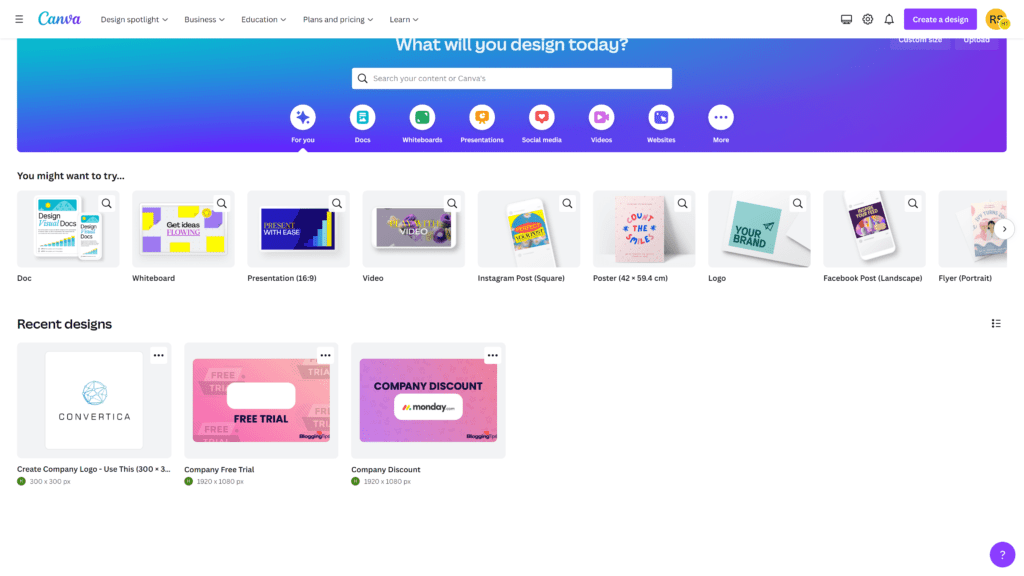
Canva is the top choice for graphic designers that need useful and intuitive design software but don’t necessarily need all of the heavyweight features that the Adobe suite of applications provides.
More than 85% of Fortune 500 companies use Canva in some capacity, and it could be an excellent fit for your business.
Key Features of Canva
- Extensive Asset Library: Tons of royalty-free images, fonts, and graphics that you can use commercially in your designs.
- One-Click Sharing & Import: Share your completed work to social channels or import content from sources like DropBox or YouTube with one click.
- Collaboration Tools: Add comments, share work amongst your team, and receive real-time feedback on your designs.
- Background Remover: Remove photo and graphic backgrounds with a single click to incorporate elements with transparent backgrounds into your work.
- Scheduling: Schedule posts to your social and digital channels and Canva will handle the rest when it’s time for your work to go live.
Why Is Canva a Great Solution?
Canva is an excellent solution for most graphic design needs because it has a much lower learning curve than other software.
Canva can hang with heavyweight design applications in most ways.
Plus, its lightweight interface and uncluttered design make it far easier for newbies to understand.
Pros of Canva
- Comprehensive asset library
- Excellent brand management tools
- Much lower learning curve than Adobe software
Canva scores high marks for its impressive collection of free-to-use assets and its foolproof brand management tools.
This allows anyone on your team to produce on-brand designs.
It’s also significantly easier to learn and understand than other software.
Cons of Canva
- Limited export options
- Limited control over elements
- No tools for style matching
There are some significant drawbacks to Canva when exporting your work into different formats.
Most lossless formats aren’t supported.
You also cannot create your own design elements.
Instead, you’re tethered to what Canva provides.
Lastly, there are no options for style matching, and you’ll have to handle all that manually.
Canva vs. Other Top Recommendations: How They Compare
Compared to the heavyweight design software offered by Adobe and Corel, Canva is definitely the lightweight of the bunch.
Still, the software is packed with valuable tools and features, and for the average business, Canva is a perfect choice for all your design needs.
Canva Pricing
- Canva Free: $0 per month
- Canva Pro: $12.99 per month ($119.99 per year)
- Canva for Teams: $14.99 per month for up to five users ($149.90 per year)
Can You Try Canva for Free?
Canva offers a free-for-life plan that allows you to take advantage of most program features at no charge.
The company also regularly provides a discount on Canva to help users save money when upgrading to Canva Pro.
Conclusion: Should You Choose Canva?
Canva is an excellent choice for light and medium-duty graphics applications.
There’s practically no learning curve, and you can easily take care of most design tasks in Canva.
Professional designers who need high-level tools will probably feel more comfortable with an Adobe product or CorelDRAW.
The Best Free Design Software Options
For users with occasional design needs and bootstrapping startups trying to keep their costs as low as possible, you can try some free options.
Below, we’ll take a closer look at two of the best free design software options, DesignWizard and Setka Editor.
DesignWizard
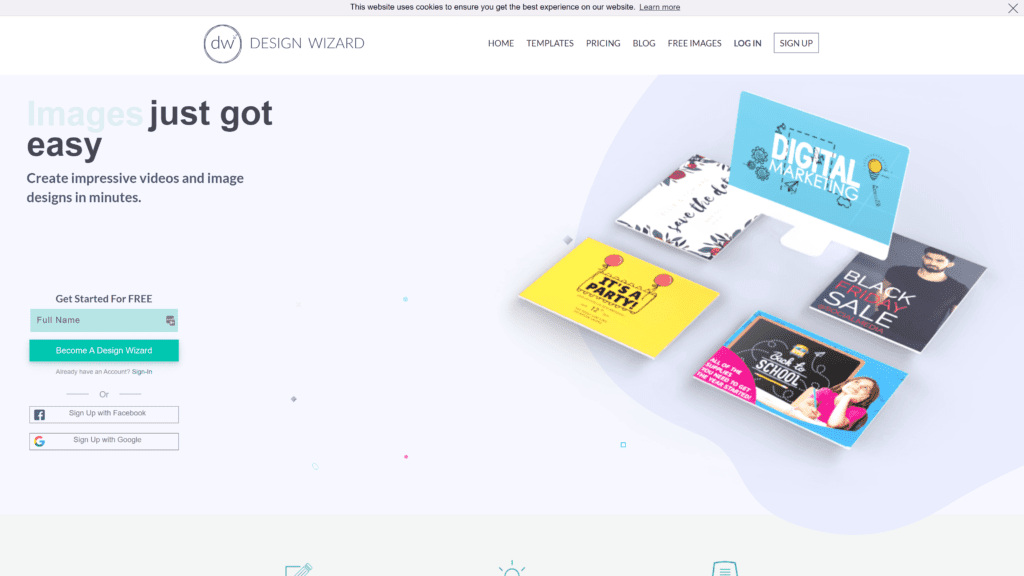
DesignWizard is positioned as a direct competitor to Canva, and the programs are similar.
DesignWizard boasts some nifty video editing tools.
These are especially handy for web and social media applications.
Furthermore, this application offers a streamlined dashboard.
This makes navigating the program’s different features easy.
Why Is DesignWizard a Great Option?
DesignWizard is an excellent option because they offer a robust free software version with a generous array of features.
The video editing tools are helpful for social media.
Also, the platform has one of the lowest learning curves of any graphics software available today.
Drawbacks to DesignWizard
DesignWizard doesn’t offer the robust brand management tools of some competitors.
In addition, it’s even more restrictive in terms of the formats you’re able to download your work.
While DesignWizard offers an exceptionally robust library of royalty-free images, you’ll need to subscribe to one of their paid plans to take advantage of this feature.
Setka Editor
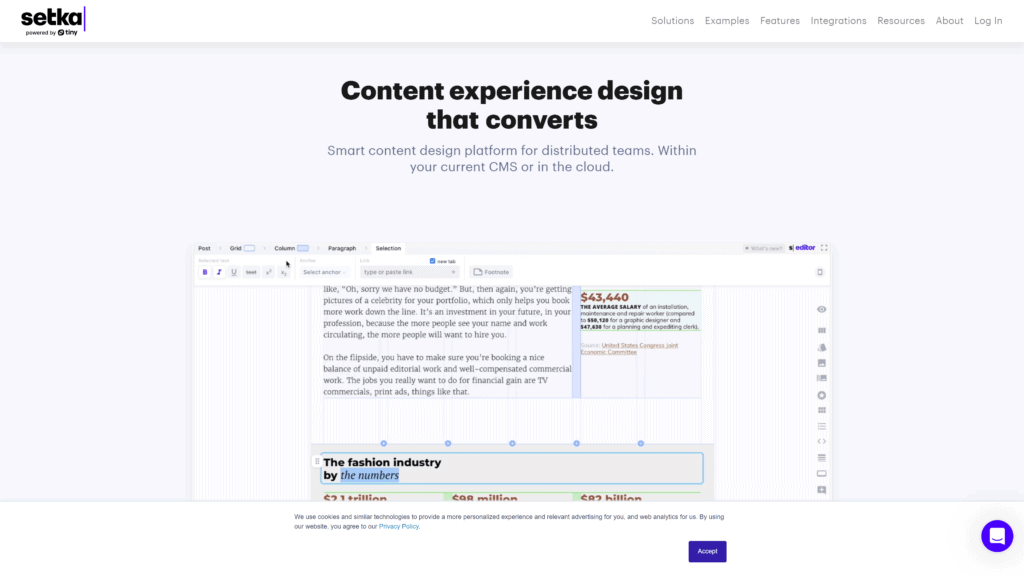
Setka Editor is a unique platform that’s somewhat similar to Adobe InDesign.
Setka Editor focuses primarily on desktop publishing and integrates with popular content management systems and web hosts like WordPress, Magneto, or Shopify.
Why Is Setka Editor a Great Option?
Setka Editor helps streamline website graphic design and publishing.
This allows business owners to automate styles and save time while creating new content or blog posts.
For businesses with basic design needs that want to improve the look and feel of their websites, Setka is a powerful tool.
Drawbacks to Setka Editor
There are a few drawbacks to SetkaEditor, which limit its present usefulness.
For one, the platform isn’t accepting new users, which is a significant speed bump.
Outside of that, it lacks the basic graphic design features other platforms do.
Instead, it serves primarily as a desktop publishing tool.
Notable Mentions: Notable Mentions: Other Design Software To Check Out
We’ve covered some excellent options for your design needs thus far.
But there are still so many excellent platforms to look into before making your decision.
Read on as we cover another handful of notable design tools that may make an ideal fit for your business.
Sketch
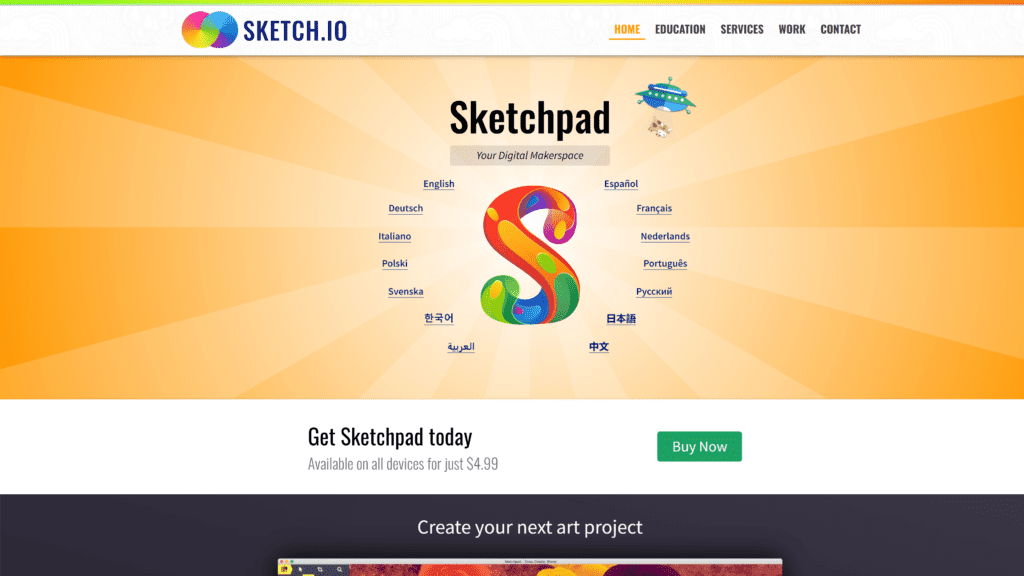
Sketch is a powerful tool that’s become a go-to for digital product designers.
Sketch offers tools similar to Adobe XD or Figma, with a significant focus on collaboration.
For concept designs, icons, and web elements, Sketch is tough to beat.
It’s also accessible enough for newbies to learn and has a lower learning curve than most product design solutions.
Why Is Sketch a Great Option?
Sketch is a go-to option for design businesses focusing on digital products like mobile apps and websites.
The platform offers powerful design tools that are native to the way digital product designers work.
Moreover, it eliminates the need to work across several different design programs to get the job done.
Drawbacks to Sketch
For businesses and individuals outside the world of digital product design, Sketch’s wide selection of tools is not as impressive.
Sketch is an awesome tool, provided the niche it sits in is compatible with your design needs.
Otherwise, you may be better suited with another application.
Sketch Pricing
- Sketch Standard: $9 per month per user ($99 per year per user)
- Sketch Business: $240 per year per user (for teams of 25+ users)
Can You Try Sketch for Free?
Sketch offers one of the most generous free trial periods of any design software.
Sketch provides a 30-day free trial which allows users to fully evaluate the product before paying for it.
If you cancel your service within that 30-day trial period, you won’t be charged for using Sketch.
Figma
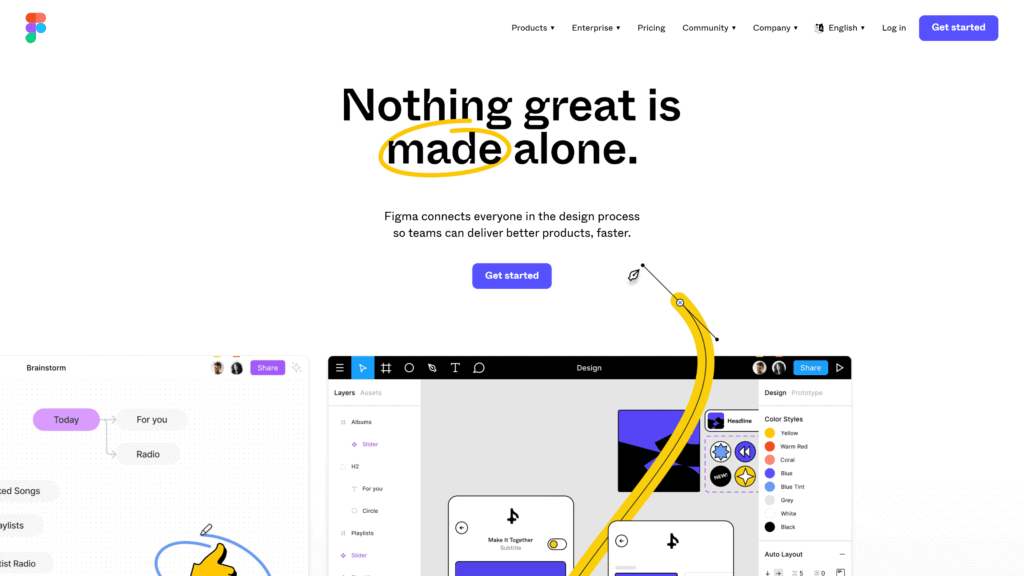
Figma is another digital product design software similar to Sketch or Adobe XD.
Figma offers powerful tools for design and prototyping that make it easy to create graphics and collaborate with other stakeholders on your team.
Figma also provides an extensive selection of plugins and widgets to help save you time while designing.
Why Is Figma a Great Option?
Figma is an excellent option for product designers and design teams that need to be able to create graphics for mobile apps, websites, and other digital products.
With baked-in collaboration tools, a native whiteboard application (FigJam), and a selection of plugins that help simplify your workflow, there’s tons to like about Figma’s platform.
Drawbacks to Figma
Regarding design tools, Figma has an edge over most of its competitors.
But, they lack an offline version of the program and don’t offer real-time collaboration tools as Sketch does.
Outside of these small caveats, Figma could be the best option for product design.
Figma Pricing
- Starter: $0 per month
- Figma Pro: $15 per month per user ($144 per year per user)
- Figma Organization: $540 per year per user
- Figma Enterprise: $900 per user per year
Can You Try Figma for Free?
Figma’s free trial is one of the most generous in the business.
Users can take advantage of Figma’s free-for-life plan, which provides nearly full access to the features and assets you’ll find in Figma Pro.
The caveat is you’re limited to creating three Figma and three FigJam files.
So you’ll need to delete older work to start a new one once you reach that three-file quota.
Adobe XD
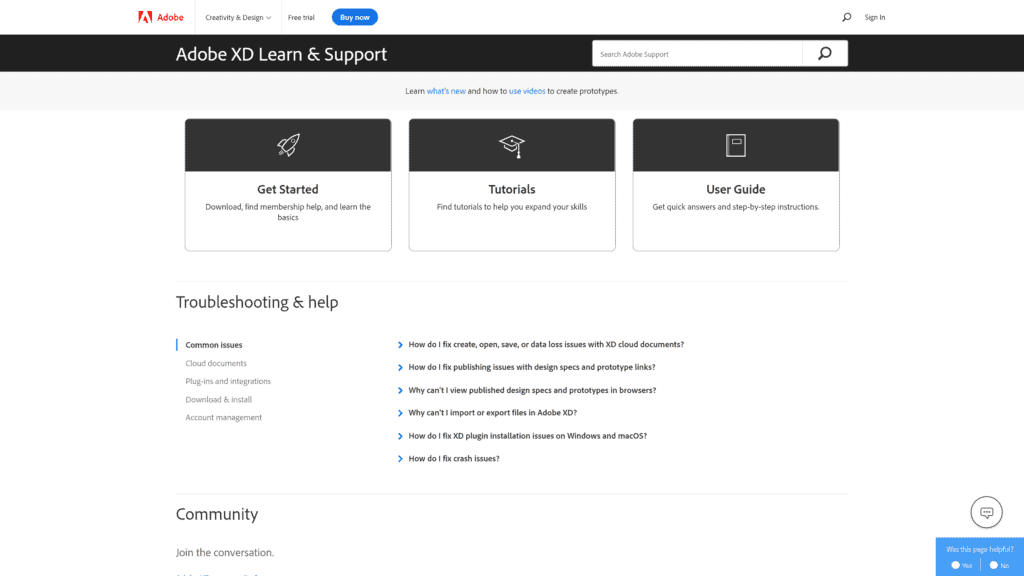
Adobe’s answer to UI/UX design features all of the tools designers need to bring apps and websites to life.
Plus, it carries Adobe’s reputation for producing excellent software.
Like other Adobe products, it also features a robust knowledge base to help new users acclimate to the platform.
Why Is Adobe XD a Great Option?
Adobe XD provides powerful tools to assist designers with every aspect of the product design process.
Tools like 3D transformation, component templates, and content-aware layouts can save designers tons of time while producing polished and beautiful-looking work.
You can also easily import your work from other Adobe platforms, such as Photoshop or Illustrator.
Drawbacks to Adobe XD
Adobe XD has some notable drawbacks that may make other products a better fit for you.
Surprisingly, there’s no option for creating custom shapes, and you’re bound to the program’s presets.
The pen tool also functions very differently from how it works in other Adobe programs.
This can cause headaches for designers who also use Photoshop or Illustrator.
Adobe XD Pricing
- XD Individual: $9.99 per month ($99.99 per year)
- XD Business: $22.99 per month ($275.88 per year)
Can You Try Adobe XD for Free?
Yes, new users can take advantage of a 7-day free trial of Adobe XD.
During the trial period, you’ll have full access to all XD features to evaluate the product.
If you decide XD isn’t for you, you can cancel within the first seven days, and you’ll never be charged for the product.
Vectr
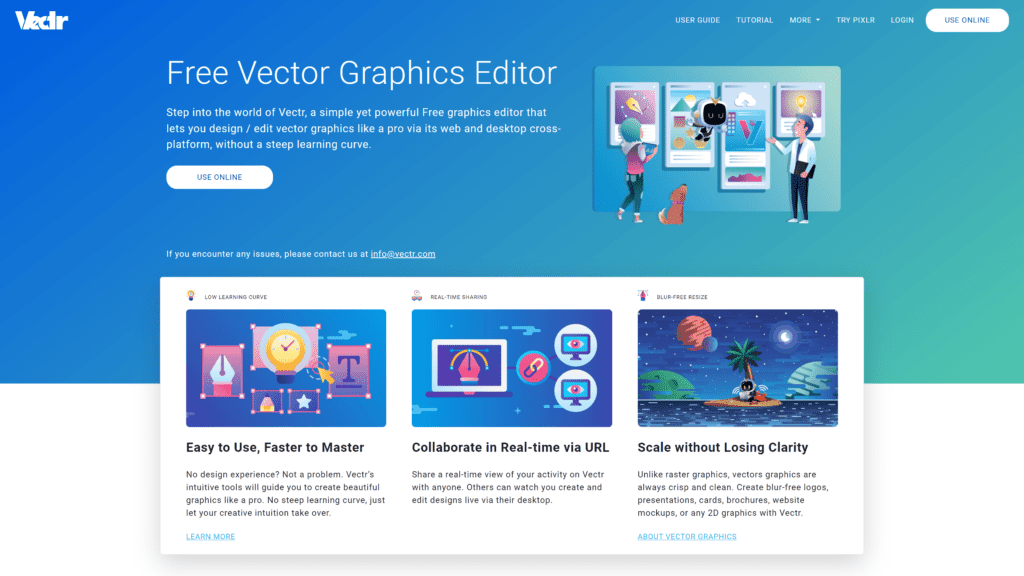
The creators of Vectr set out to design software accessible to anyone, regardless of their level of design experience.
While their application might not rival Illustrator or Sketch, they’ve created a powerful and easy-to-use tool that any designer or business can use to create awesome vector art.
Why Is Vectr a Great Option?
One of the major positives of Vectr is their platform is entirely free to use.
Vectr delivers basic tools like pencil, pen, shapes, and text, and the ability to add styles and effects to layers and assets.
The online-only interface also comes in handy if you ever start a project on one device and want to pick it up on another.
Drawbacks to Vectr
One of Vectr’s strengths is that it’s entirely free, but that’s also a weakness.
A free program like Vectr can’t compete with the heavyweight software intended for serious designers.
If you need software like that, you’ll find Vectr underpowered.
Vectr Pricing
The Vectr app is free-for-life for all users, and there is no paid version of the software.
Can You Try Vectr for Free?
Yes, all users can enjoy the full version of Vectr for free.
There’s no trial period, and users can use the software free in perpetuity.
Affinity Designer
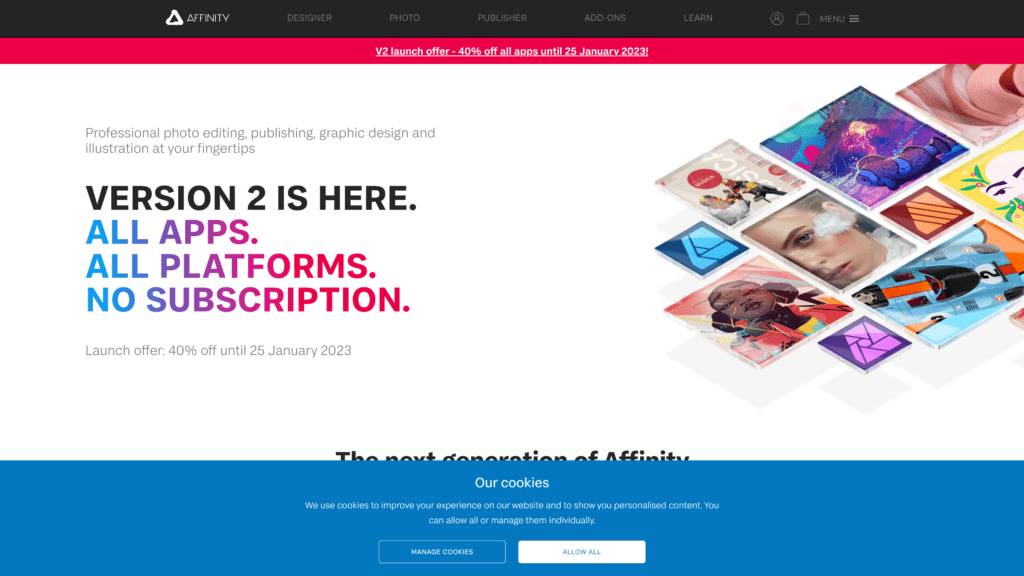
Affinity Designer could be an ideal choice for designers who need a program that provides Illustrator-like tools and functionality but isn’t interested in a SaaS solution.
This powerful Illustrator competitor offers powerful tools that are highly responsive.
Moreover, it comes at an affordable price tag any designer can appreciate.
Why Is Affinity Designer a Great Option?
Affinity Designer has long been a viable competitor to Illustrator.
But the latest version is even faster with a more robust selection of tools.
It’s also significantly cheaper than the competition because you pay once and own the software forever.
Drawbacks to Affinity Designer
The drawbacks to Affinity Designer are few and far between, but there are some.
This application doesn’t have any plugins or integrations.
Furthermore, it lacks a few notable features, such as vector pattern making or object tracking.
There’s also a slightly higher learning curve than Illustrator.
And you don’t have the advantage of Adobe’s robust knowledge base to help you navigate the software.
Affinity Designer Pricing
Affinity V 2.0 Universal License: $99.99
Can You Try Affinity Designer for Free?
Affinity Designer offers a generous 30-day free trial that carries no risk for the user.
To take advantage of the trial, provide some basic details to create an account, and they’ll give you a download link.
The download link offers complete access to the V2 software suite for 30 days, and no credit card is required to initiate the trial.
CorelDRAW
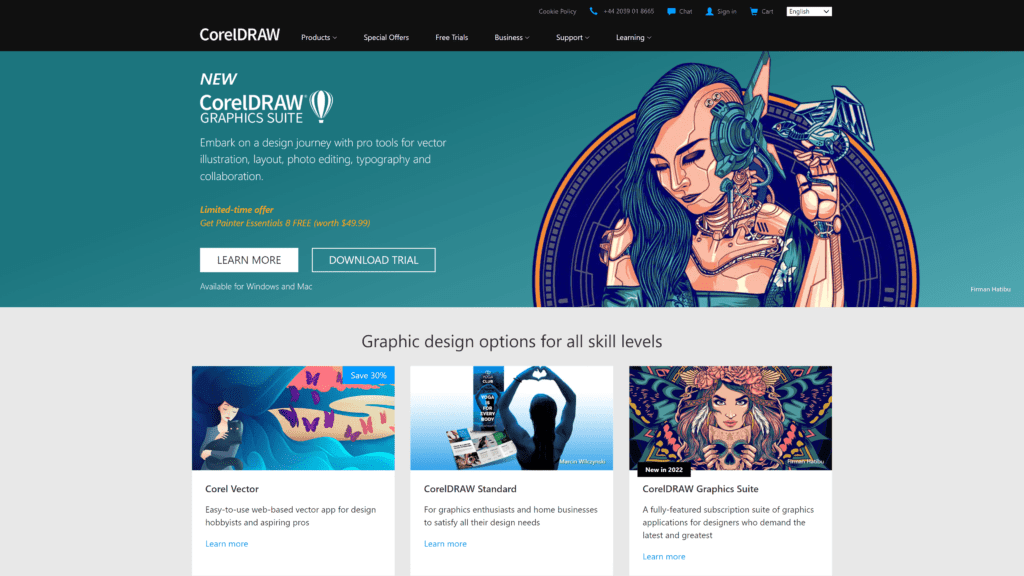
CorelDRAW has long been the undisputed number one contender to Adobe Illustrator.
In recent years, they’ve further solidified that claim.
CorelDRAW is a vector graphic and layout program that offers a suite of additional tools comparable to the Adobe Creative Suite.
For any designer looking for a viable alternative to Adobe, CorelDRAW is the best bet.
Why Is CorelDRAW a Great Option?
CorelDRAW is an excellent option for a score of reasons.
Most importantly, the program provides nearly all the same functionality as Illustrator.
There are also some extra functions that you can’t get from Illustrator without using plugins.
Notably, CorelDRAW is a more flexible option than Adobe products because they provide the opportunity to purchase a perpetual license or subscribe to a monthly service.
For users interested in a perpetual license, there are three different tiers you can buy to fit the needs of designers with different budgetary requirements.
Drawbacks to CorelDRAW
There are a few drawbacks to CorelDRAW that you’ll want to consider before deciding if it’s the best choice for you.
CorelDRAW lacks the baked-in collaboration features that Adobe does.
This can be a significant caveat for larger teams who rely on collaboration tools.
There’s also a slightly higher learning curve with CorelDRAW, mainly because they don’t have the robust help database that Adobe provides.
CorelDRAW Pricing
- CorelDRAW Graphics Suite Perpetual License: $424
- CorelDRAW Standard Perpetual License: $299
- CorelDRAW Graphics Suite Subscription: $269 per year
Can You Try CorelDRAW for Free?
Yes, Corel offers a 15-day free trial for users looking to take a closer look at the software before committing.
Not only does Corel offer a generous trial, but it’s easy to get.
Corel offers a one-click download of the software, and no credit card or personal information is required to begin the trial.
Even More Options To Check Out
We’ve covered the bulk of the best graphic design programs on the market.
But there are still several more options you’ll want to consider before making your final decision.
Be sure to check these applications out before you select software.
Adobe Creative Cloud Express
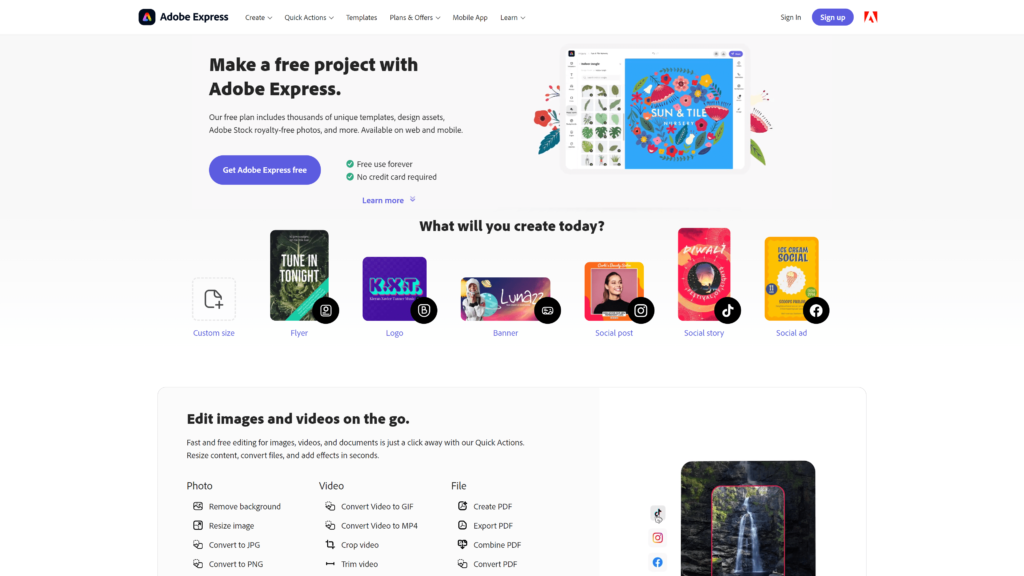
Creative Cloud Express is Adobe’s lightweight and inexpensive graphics software that’s an excellent choice for basic design needs.
If you’re creating posts for social media, small web assets such as banners or logos, or newsletters, Express’s tools are often more than enough to get the job done.
There are a few missing pieces to the free version, like adding your logo or brand assets to your work.
Thankfully, a paid version of the software provides users access to a massive library of fonts, royalty-free images, and creative assets that can take your work to the next level.
Adobe also offers a free 30-day trial you can take advantage of to evaluate the product.
Moqups
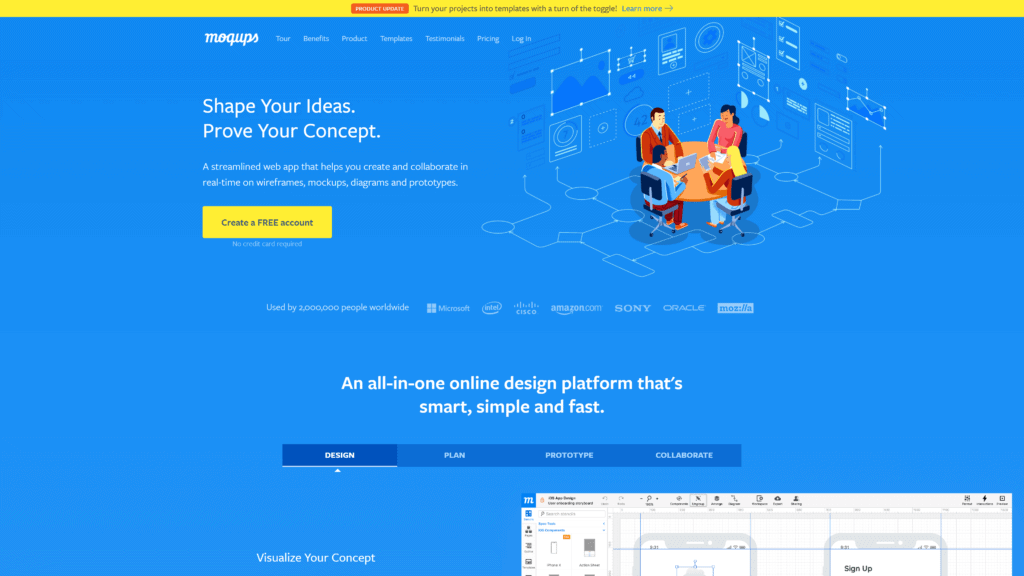
Moqups is an intriguing UI design tool that houses several critical tools under one roof.
This allows designers to use a single software to address a wide variety of prototyping and design tasks.
This application is loaded with time-savers.
These include templates for any use case and a library of popular icons and design elements.
Furthermore, there’s a drag-and-drop functionality for importing photos and assets into the program.
There are also plenty of collaboration tools that make it easy to interact with your team.
Eagle
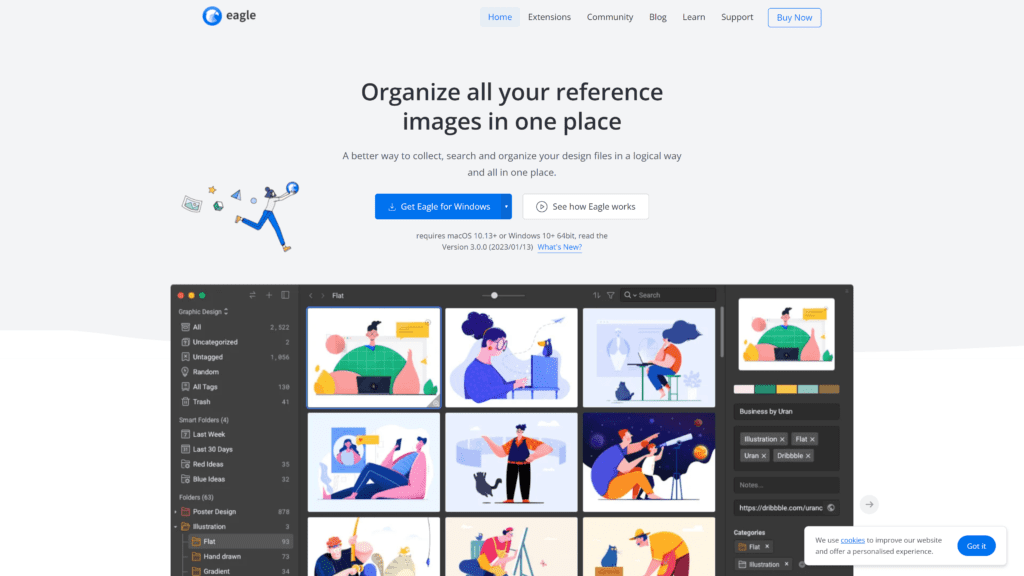
While it isn’t a standalone design application, Eagle is an intriguing software that every graphic designer will want to familiarize themselves with.
This particularly applies to product and web designers.
Gathering images and references for product research is tedious.
And organizing and cataloging those references becomes even more tedious.
Eagle makes organizing and cataloging references significantly more accessible.
This allows designers to spend more time working instead of trying to find reference images.
Users can easily tag, filter, and search for references in an intuitive way that takes seconds instead of hours.
Any product or UI designer will want to add this inexpensive software to their toolkit.
Inkscape
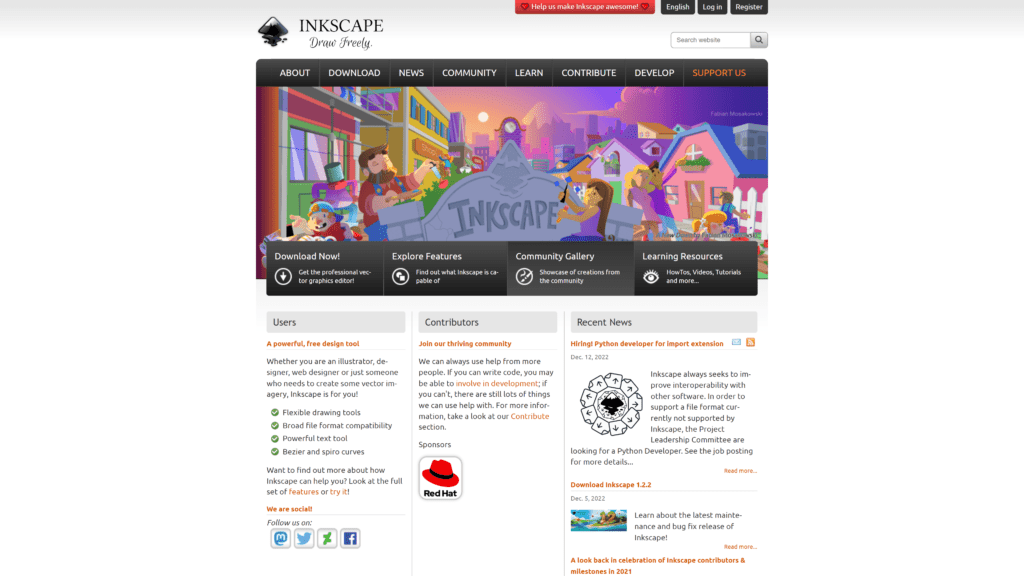
Inkscape is a powerful open-source tool that delivers powerful vector graphic design functionality.
This makes it worth taking a closer look at, especially since the software is free.
It provides support for an incredible range of file types.
Moreover, its tools are expandable with the help of plugins.
If you can do it in Illustrator, chances are, you can do it in Inkscape, too.
While this software lacks Illustrator’s processing power and polished look, it’s still exceptionally full-featured.
This is likely a reasonable and acceptable trade-off for designers on a budget.
VEED.io
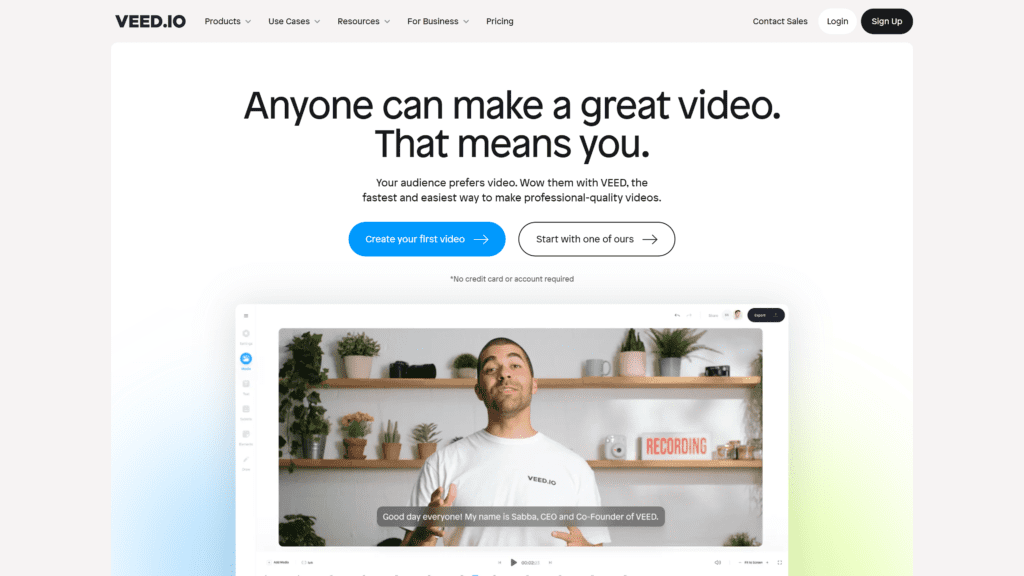
For businesses who need to incorporate video into their marketing mix, VEED.io is one of the best tools on the market to take a closer look at.
The program offers a full-featured video editor, screen recorder, and a host for live streaming to the platform of your choice.
You can also add subtitles to videos, which is crucial, considering most people listen to social videos without sound.
VEED also has a free plan that includes a generous array of features, providing nearly all the functionality of their paid plans.
While the platform doesn’t offer any graphics editing features, it’s still worth a closer look.
Especially considering how vital video marketing is in the 21st century.
Gravit Designer Pro
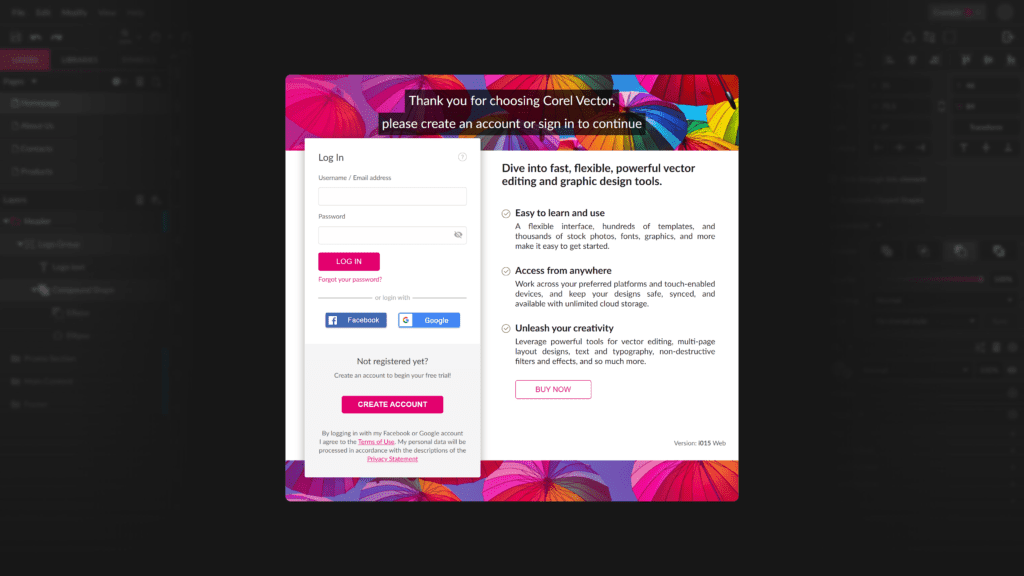
Gravit Designer Pro recently underwent a facelift as the platform was purchased by Corel and renamed Corel Vector.
This software strikes an excellent balance as lightweight and accessible software that anyone can use.
It provides high-level design tools that allow you to create breathtaking vector designs.
This cloud-based software is accessible anywhere there’s a web browser.
It also has unlimited storage, so you never have to worry about running out of room for new projects.
Notably, Corel provides a generous 15-day trial period, and the full version of the program is quite affordable.
Considering all its high-end features, Corel Vector is an excellent choice for value seekers.
Other Products Relevant to Design Software
Beyond graphic design software, many other programs will aid you in achieving your business goals.
Be sure to consider adding the software below to your technology stack to reinforce your brand further.
Best Graphic Design Software: Explanation
Graphic design tools can help you establish a presence for your business and lend a polished look to all your marketing materials.
From photo editing software like Photoshop to robust vector graphics programs like Illustrator, capable graphic design software is a crucial component for any business.
If you’re looking to get into the world of graphic design, design blogs can provide inspiration.
Once you’re ready to select software, check out our best graphic design software here.
Best Website Design Software: Explanation
Creating an easy-to-navigate, visually appealing, and professional website is a critical step that every business must take.
For most businesses, a website is the first exposure to your company that a potential customer will have.
So it’s essential you put your best foot forward.
The best website design software ensures that you’re providing your audience with the best first impression.
Best Logo Makers: Explanation
Sometimes, you don’t need a full-featured graphic design application with many features and functionality.
The best logo makers make it easy for you to create a unique logo that captures the attention of your audience and the spirit of your brand.
Best of all, these programs only take a few minutes to create engaging and memorable logos.
Frequently Asked Questions
Most people have a few related questions when learning about different design software options.
We’ve answered them below so you can find all the information you need in one place.
What software do designers use?
Graphic designers rely on several different software programs, depending on the type of work they do and their personal preferences.
The most popular software among designers includes Adobe Illustrator, InDesign, Photoshop, and CorelDRAW.
Is AutoCAD design software?
AutoCAD is a design software that allows architects and engineers to map out 2-and-3 dimensional designs.
AutoCAD is used to create blueprints, design product and idea mockups, and create designs for 3D printing.
Wrapping Up
With so many options available, it takes extensive research and careful consideration to select the best design platform for your needs.
Considering its unrivaled selection of features and tools and powerful collaboration support, Adobe Illustrator is the clear winner as the best design software.
Other platforms simply don’t provide the precise control over your work that Illustrator does, and the introduction of the Discovery Panel helps to simplify Illustrator’s once steep learning curve.
As an alternative, CorelDRAW and Vectr are worth taking a closer look at.
If you’re ready to take your graphics and artwork to the next level, take a closer look at Adobe Illustrator here.


